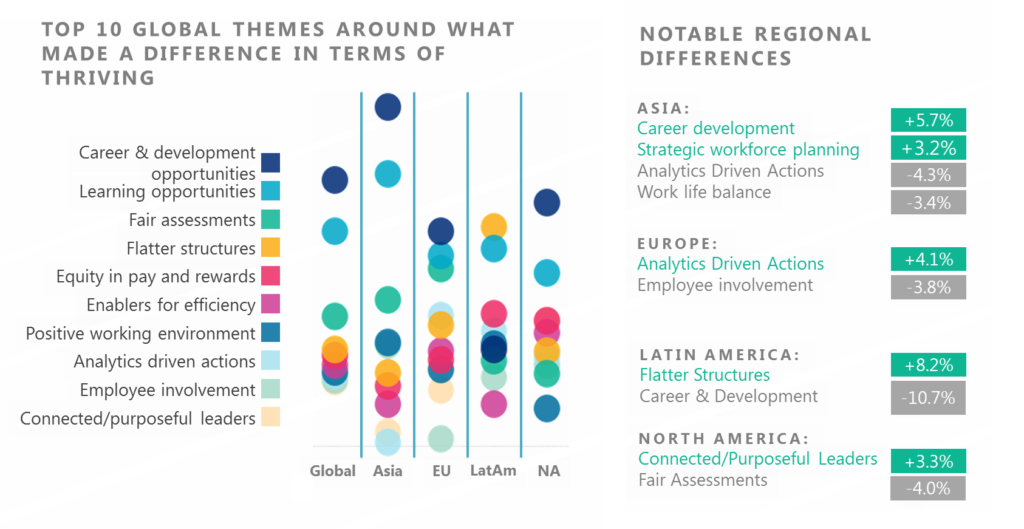Empowering Talent in Emerging Markets To Thrive Amidst Disruption

Office workers in the Raffles Place financial district in Singapore. Employees in Asia are seeking more opportunities to grow their careers and develop.
Photo: Jimin Lai/AFP/Getty Images
Every organization has a vibe, a feeling that is clearly discernible but difficult to pin down, and you can feel this vibe the moment you step into a workplace. Some organizations feel hectic and stressful. Others seem cold and sterile, or worse still—dull. But a few—a rare few—are different.
Walk inside these organizations and one thing is clear: People are genuinely excited to be there. A perceptible buzz—an undercurrent of energy and vitality—permeates the place. A clear sense of pride, passion and purpose is evident in employee interactions, customer facing or not. This passion is evident in the products and services and manifests itself in customer touch points. These organizations, far from being disrupted, have become even more resilient amidst digitization, having found newer ways to harness the collective energies of their employees to leverage technology.
In research recently released by Mercer, we explore what it takes for organizations to thrive from a people standpoint as a way to uncover some key attributes of organizations that have been able to create this rare vibe of passion and purpose.
The first thing that becomes clear about such organizations is that they have fundamentally transformed the idea of “going to work” for their employees and turned it into a compelling experience, one that is meaningful to each employee individually. As part of this survey, we heard from over 800 HR and business leaders regarding the cultural drivers and people practices that made a difference to thriving at work. Growth and learning stood out, as did a sense of equity in pay and promotion. Creating such a culture is the foundation for building businesses that are resilient to disruption.
We also heard regional differences around what it takes to thrive. Companies in North America placed emphasis on a leader’s style and the importance of their relatability, accessibility and “their ability to connect with the workforce.” The perceived fairness of talent assessments was also important—that is, “equal access to experiences,” “clear assessment for development opportunities,” and “transparent promotion choices.”
In emerging markets such as Asia and Latin America, respondents were most vocal on the criticality of career and development transparency, “clarity around promotion criteria,” and “career frames that define the experiences and skills you can gain.” Organizational design was part of the message from Latin America—“build flatter structures,” “have less levels,” “move to agile work structures.”
Europe and Asia both shared how they have reaped the return from workforce analytics “data that tracks the progress of diverse groups,” and “data to know what people want, actually use, might need—linked to life events.” Respondents in Europe also mentioned the importance of involving employees in the decision-making and change actions that are being driven, specifically “involving employees in discussions about why we need to change,” “getting people involved with new initiatives early” and “involving them in innovation.” Additionally, employees seek to work for an organization whose purpose not only resonates with their own but also creates a broader social impact.
Across these topics, five universal drivers to creating a culture of thriving emerged:
Various doomsday forecasts around job losses on account of automation notwithstanding, we need to understand the impact of technology on jobs from an employee’s vantage point. That employees in Asia seek more opportunities to grow their careers and develop isn’t surprising, given the soaring aspirations on the back of technological strides underway in the region.
Thriving organizations place a premium on people and invest in their development, especially to make them “digital-ready.” One of Asia’s leading banks, DBS, for example, recently announced that it would invest $20 million over the next five years to raise the digital competence of 10,000 of its employees in Singapore.
With the advent of new technologies such as artificial intelligence, fostering a culture of continuous learning is paramount for organizations to thrive. They realize that to generate best-in-class performance, they need to attract and retain the best talent pool. Thriving organizations go to great lengths to ensure that their talent management practices not only appeal to a wide range of employees but resonate with what they want for themselves and their families.
They create thriving workforces that are diverse and adaptive, inclusive and growth-focused, and are committed to the physical, financial and emotional well-being of their employees.
Mercer’s Thrive research can be accessed here.




